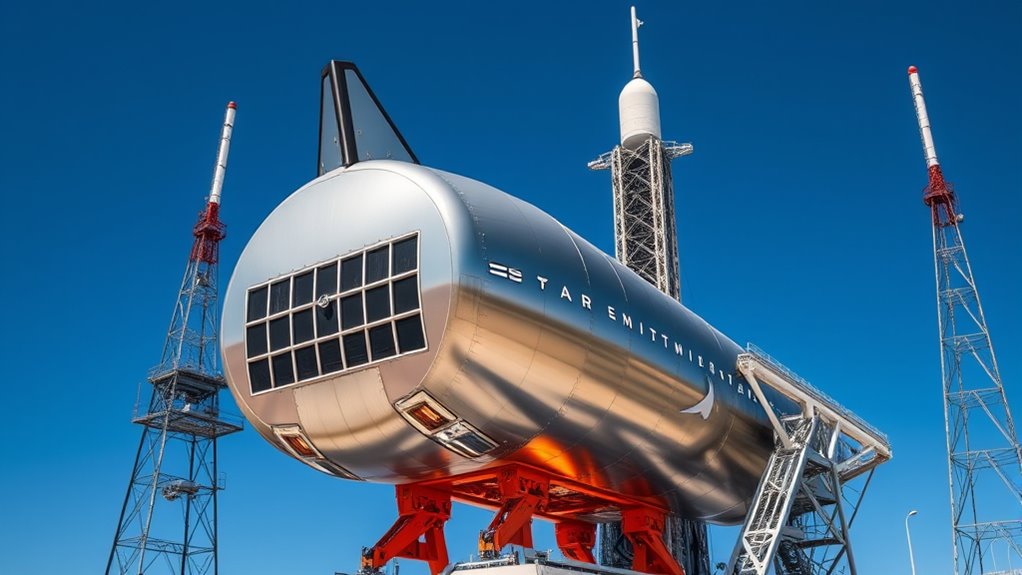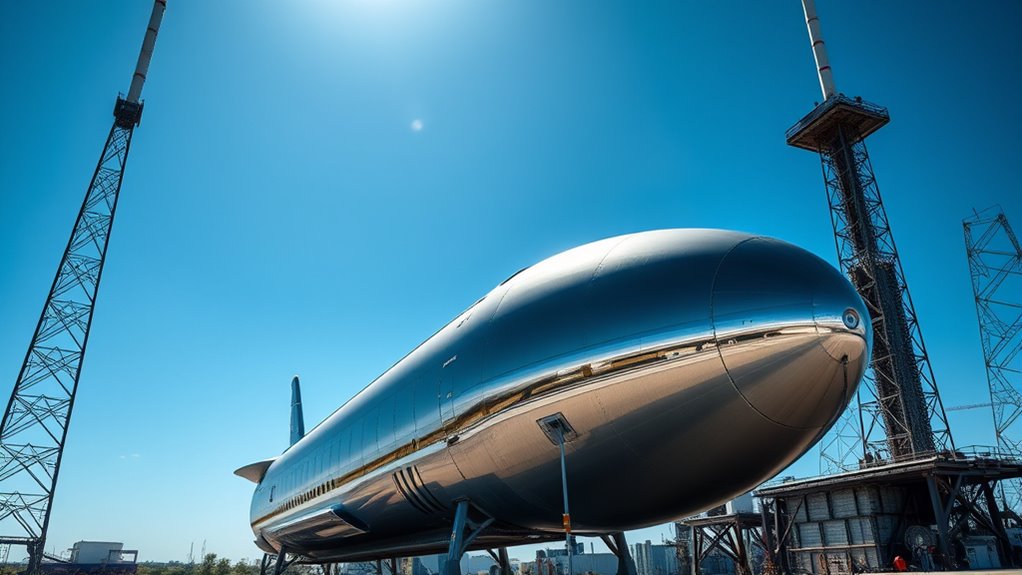SpaceX’s Starship is now prepared for its second orbital test flight after completing essential upgrades. This includes enhancements to its thermal protection system, reusability features, and precise landing procedures. These improvements aim to demonstrate safe, reliable re-entry and quick turnaround times, bringing Starship closer to routine reuse and ambitious deep space missions. If you keep exploring, you’ll discover how these advancements could reshape space travel and humanity’s future among the stars.
Key Takeaways
- SpaceX successfully completed the second test flight of Starship, demonstrating progress in spacecraft capabilities.
- Upgrades focused on thermal protection and reusability, critical for safe atmospheric re-entry and multiple missions.
- The test emphasized precise landing procedures to ensure safe recovery and rapid turnaround potential.
- Enhanced thermal protection systems now withstand extreme reentry heat, supporting future deep-space missions.
- These advancements bring Starship closer to reliable orbital flights, enabling sustainable missions to the Moon and Mars.

SpaceX has successfully conducted the second test flight of its Starship spacecraft, marking a significant milestone in its development. This achievement demonstrates the company’s progress in refining the vehicle’s capabilities for future missions. One of the key aspects of this test was evaluating the rocket reusability, a cornerstone of SpaceX’s design philosophy. You can see how the company has focused on making Starship more cost-effective by enabling rapid turnaround times. After each launch, the goal is to recover and reuse the spacecraft’s components with minimal refurbishment, which directly impacts operational efficiency and mission affordability. During this test flight, you observe the importance of precise landing procedures, as the spacecraft aims to touch down safely, ready for its next mission. This focus on reusability aligns with SpaceX’s broader strategy to create a sustainable space transportation system. You’ll also notice how the integration of thermal protection systems is critical for managing reentry heat, ensuring the spacecraft can withstand the extreme temperatures encountered during atmospheric entry. Another critical area the test addressed was thermal protection. As Starship re-enters Earth’s atmosphere at high speeds, it faces extreme heat and aerodynamic stresses. You notice the enhanced thermal protection system during the flight, designed to shield the spacecraft from temperatures that can reach thousands of degrees Fahrenheit. The upgraded thermal protection tiles and insulation materials work together to absorb and dissipate heat, preventing damage to the craft’s structure. This system’s success is essential for ensuring safe re-entry and safe recovery of the vehicle. You’ll see how the thermal protection system not only safeguards the spacecraft but also contributes to its reusability, as it must withstand multiple re-entry cycles without significant degradation. The improvements made after previous tests aim to extend the lifespan of these heat shields, reducing costs and increasing the frequency of reuse. Throughout this flight, you witness how these advancements support SpaceX’s vision for a fully reusable spacecraft capable of carrying humans and cargo to destinations like the Moon and Mars. The integration of robust thermal protection with a focus on rocket reusability signals a step closer to making deep space missions more practical and economical. As the spacecraft lands, you realize that each successful test brings SpaceX closer to achieving reliable, routine reuse, which is essential for the future of space exploration. The combined focus on refining thermal protection and boosting reusability underscores the company’s commitment to innovation and sustainability in space travel. With these improvements, Starship is establishing itself as a crucial asset for humanity’s next giant leap into the cosmos.
Frequently Asked Questions
What Specific Upgrades Were Made to the Starship?
You’ll find that the Starship upgrades include advanced thermal protection, improved avionics, and reinforced structure for better durability. The booster enhancements feature upgraded engines and increased thrust capacity, making launches more reliable. These improvements aim to increase payload capacity and safety, ensuring the spacecraft can handle more demanding missions. By focusing on these booster enhancements and structural upgrades, SpaceX is pushing toward more successful orbital flights and long-term space exploration.
How Long Is the Expected Duration of the Second Test Flight?
The expected test flight duration is around 90 minutes, aligning with SpaceX’s mission timeline for this second orbital test. During this period, you’ll see the Starship perform key maneuvers, such as orbit insertion and re-entry, to evaluate its performance post-upgrades. This timeframe helps guarantee all systems operate correctly and provides valuable data for future missions. Stay tuned for real-time updates on how smoothly the mission progresses.
Will There Be Live Coverage of the Upcoming Launch?
Yes, there will likely be media coverage and live coverage of the upcoming launch. SpaceX typically provides updates on their launch schedule through their official channels, and media outlets often stream the event live. Keep an eye on SpaceX’s website and social media pages for the latest news, launch schedule updates, and live coverage details so you can watch the second orbital test flight as it happens.
What Are the Main Objectives for the Second Orbital Test?
Your main objectives for the second orbital test focus on flawless spacecraft navigation and precise mission planning. You want to verify that the upgraded Starship can successfully navigate its trajectory, demonstrate reliable launch and landing capabilities, and validate safety systems. This test aims to guarantee the spacecraft’s readiness for future missions, pushing the boundaries of space exploration while addressing potential technical challenges to improve overall performance and reliability.
How Does This Test Impact Future Crewed Missions?
This test is vital for ensuring crew safety and refining mission planning, which directly impacts future crewed missions. By validating the Starship’s systems and performance, you help identify potential risks and improve safety protocols. Successful testing builds confidence in the spacecraft’s reliability, allowing mission planners to design safer, more efficient crewed missions. Ultimately, it’s a key step toward making human space travel more secure and feasible.
Conclusion
As you watch SpaceX prepare for its second orbital test flight, you realize it’s a leap from ambitious dreams to tangible progress. While the rocket’s massive size hints at human expansion into space, the meticulous upgrades remind you that even giants need fine-tuning. In this dance between raw power and careful engineering, you see a future where space isn’t just a destination but a domain within reach—an impressive balance of chaos and control.









